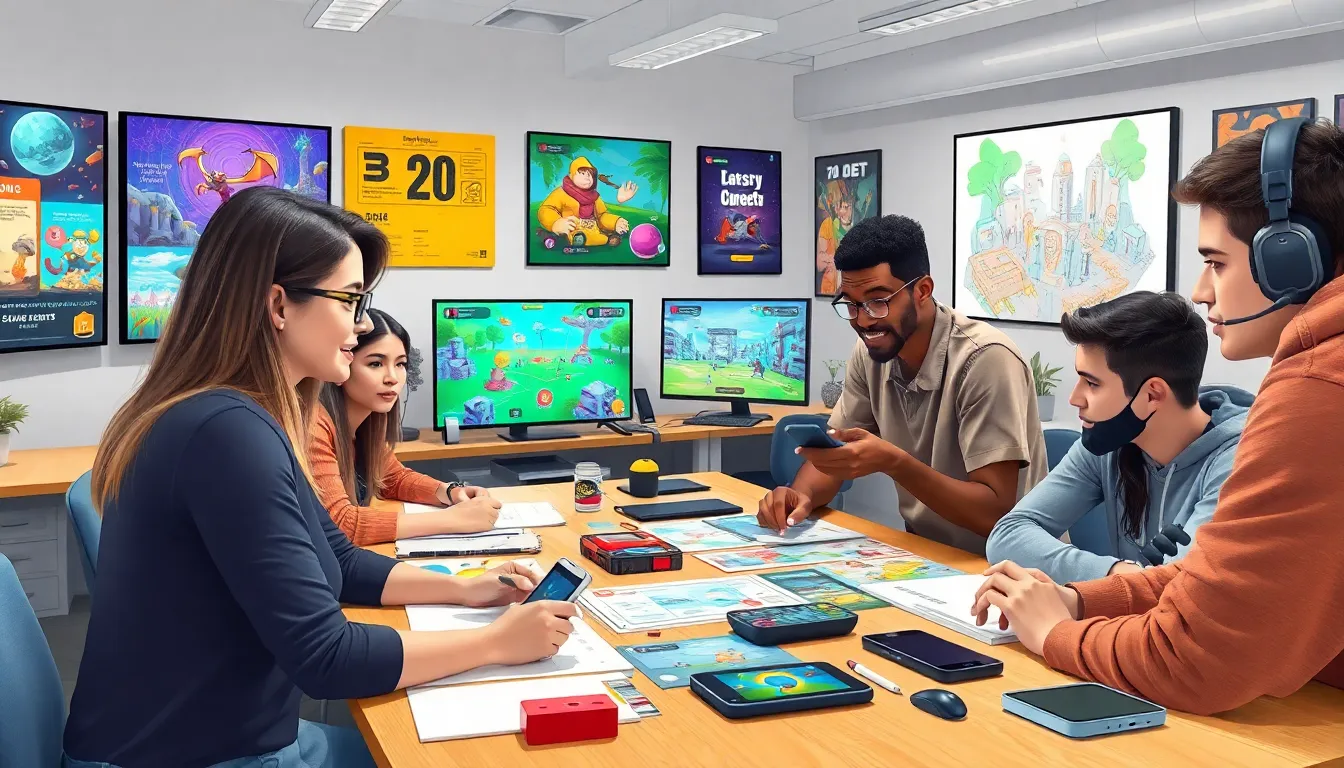In a world where players can become heroes, villains, or even a loaf of bread, game design concepts are the secret sauce that makes it all happen. It’s not just about flashy graphics or catchy tunes; it’s about crafting experiences that keep players glued to their screens. Whether you’re a seasoned developer or just curious about what makes games tick, understanding these concepts is like having the cheat codes to creativity.
From the thrill of leveling up to the agony of unexpected plot twists, game design is a delicate dance between challenge and reward. Dive into the intricacies of mechanics, aesthetics, and storytelling that transform mere pixels into unforgettable adventures. Get ready to explore the art and science behind the games that make us laugh, cry, and occasionally throw our controllers.
Table of Contents
ToggleOverview of Game Design Concepts
Game design concepts encompass various elements crucial for captivating player engagement. Mechanics define how players interact within the game, including rules, controls, and objectives. A strong mechanic creates a foundation for enjoyable gameplay experiences.
Aesthetics refer to the visual and auditory aspects that enhance immersion. Engaging graphics, sound effects, and music work together to create an emotional atmosphere, making players feel invested in the game world.
Storytelling plays an integral role in game design, as narratives elevate the gameplay experience beyond mere mechanics. Compelling plots and well-developed characters foster emotional connections and drive player motivation.
Balancing challenge and reward remains vital for maintaining player interest. Developers must ensure that tasks provide appropriate difficulty levels, rewarding players for their achievements without causing frustration.
User experience design focuses on creating intuitive interfaces, guiding players seamlessly through mechanics and narratives. Streamlined navigation enhances accessibility, encouraging players to explore and engage more deeply.
Iterative design processes enable constant refinement of game elements. Feedback from playtesting informs developers about player experiences, leading to enhancements that improve overall enjoyment.
Game design concepts intertwine mechanics, aesthetics, storytelling, challenge-reward balance, user experience, and iterative processes. These elements collectively create immersive and engaging environments that resonate with players.
Fundamental Elements of Game Design

Game design relies on several fundamental elements that shape player experiences. Understanding these core components enhances the quality of any game.
Mechanics
Mechanics establish the rules governing player interactions. They define how players navigate challenges and achieve objectives. Examples include shooting mechanics in action games and resource management in strategy games. Diverse mechanics create unique gameplay experiences. The effectiveness of mechanics often hinges on clarity and consistency, ensuring players understand the game’s systems. Game designers must consider how mechanics align with overall gameplay goals, fostering an experience that feels rewarding.
Dynamics
Dynamics arise from player interactions with mechanics and the game environment. Players generate different behaviors based on mechanics, resulting in varied and emergent gameplay experiences. For instance, cooperative dynamics encourage teamwork among players, while competitive dynamics ignite rivalry. Designers need to anticipate how players might react to changes in mechanics, ensuring that the dynamics foster engagement and sustain interest. Successfully implemented dynamics can lead to a vibrant player community, as interactions create memorable gaming moments.
Aesthetics
Aesthetics significantly impact the emotional connection players form with a game. They encompass visuals, sound, and storytelling elements, working together to create an immersive environment. Striking graphics attract players, while a compelling soundtrack enhances emotional experiences. The aesthetic choices made by designers contribute to world-building, amplifying the game’s narrative. Effective aesthetics draw players into the game, making them feel more immersed in the unfolding story. Designers must balance aesthetics with mechanics and dynamics, ensuring all elements work harmoniously to create an engaging experience.
Game Development Process
The game development process consists of three primary phases: pre-production, production, and post-production. Each phase plays a critical role in creating a successful game.
Pre-production
Pre-production lays the groundwork for game development. It involves brainstorming ideas and defining the game’s vision. Designers create initial concepts for gameplay mechanics, aesthetics, and storylines. During this phase, teams develop detailed design documents. These documents outline objectives, resources, and timelines. Additionally, prototypes may be created to explore gameplay mechanics. This phase ensures all team members align on the project vision before moving forward.
Production
Production is where the bulk of the game is developed. Development teams begin coding the game and implementing visual assets. Artists create graphics and animation while programmers build technical systems. Designers test mechanics to ensure fun and engaging gameplay. Regular playtesting occurs during this phase to identify areas for improvement. Continuous collaboration ensures that everyone remains on track and aligned with the project’s goals. This phase requires careful coordination to deliver a polished product.
Post-production
Post-production focuses on finalizing the game and preparing for launch. Quality assurance testers identify bugs and performance issues. Developers address feedback and make necessary adjustments. Marketing teams create promotional materials to generate excitement. Launch strategies are pipelined, including planning release dates and distribution. After launch, developers may provide updates and downloadable content to enhance player experiences. This phase ensures the game continues to resonate with its audience.
Types of Game Design Concepts
Game design concepts encompass various elements that contribute to creating immersive experiences for players. Three primary categories include level design, character design, and user interface design.
Level Design
Level design focuses on creating the environments where gameplay occurs. Designers establish layouts, pacing, and key environmental features, ensuring they align with gameplay mechanics. Each level serves as an experience that challenges players while maintaining engagement. Designers consider flow, providing natural transitions between areas, while strategic placements of obstacles enhance varying difficulty levels. A well-designed level encourages exploration and rewards players for their curiosity. Important elements like lighting and music heighten tension or tranquility, shaping emotional responses. Creating diverse environments fosters long-term player interest, leading to memorable experiences.
Character Design
Character design centers around developing unique personas that players can connect with. Distinct traits, such as appearance, abilities, and backstory, define each character’s role within the game. Designers aim for visual appeal, integrating cultural references or psychological traits to enhance relatability. Gameplay mechanics often stem from character attributes, influencing player choices and strategies. Building a character arc deepens emotional engagement, allowing players to experience growth and change alongside characters. Unique designs stimulate personal connection, increasing attachment to the overall narrative. Balanced character teams encourage diverse gameplay styles and promote teamwork within competitive environments.
User Interface Design
User interface design revolves around creating intuitive and visually appealing menus and controls. Designers prioritize user accessibility, ensuring that all elements are easy to navigate. A clean, organized layout enhances usability, allowing players to focus on gameplay rather than getting lost in menus. Designers incorporate feedback systems, including visual cues and animations, to guide players through interactions. Consistency in design elements promotes familiarity, fostering a seamless experience. Thoughtful color schemes and typography improve readability and overall aesthetic appeal. Effective user interface design enhances immersion, ensuring players remain focused and engaged throughout their gaming journey.
Game design concepts are the backbone of captivating gaming experiences. By weaving together mechanics aesthetics and storytelling designers create worlds that draw players in and keep them engaged. Balancing challenge and reward is essential for maintaining interest and fostering emotional connections.
As the industry evolves the importance of user experience and iterative design processes cannot be overstated. Each phase of game development from pre-production to post-production plays a crucial role in shaping the final product. By focusing on level character and user interface design developers can craft memorable adventures that resonate with players long after they’ve put down the controller. Embracing these concepts ensures that games remain not just enjoyable but truly immersive experiences.









